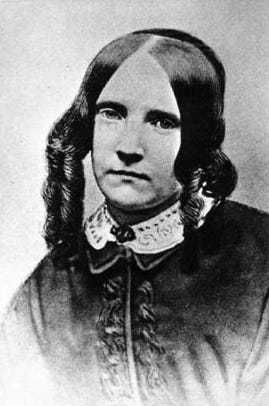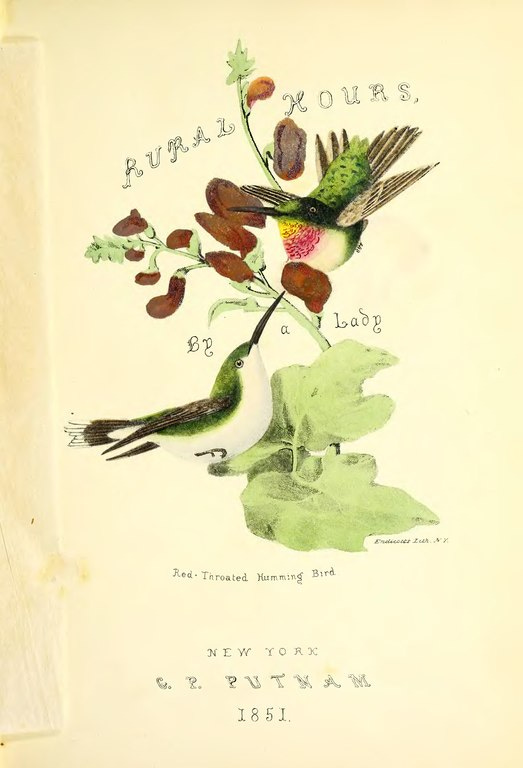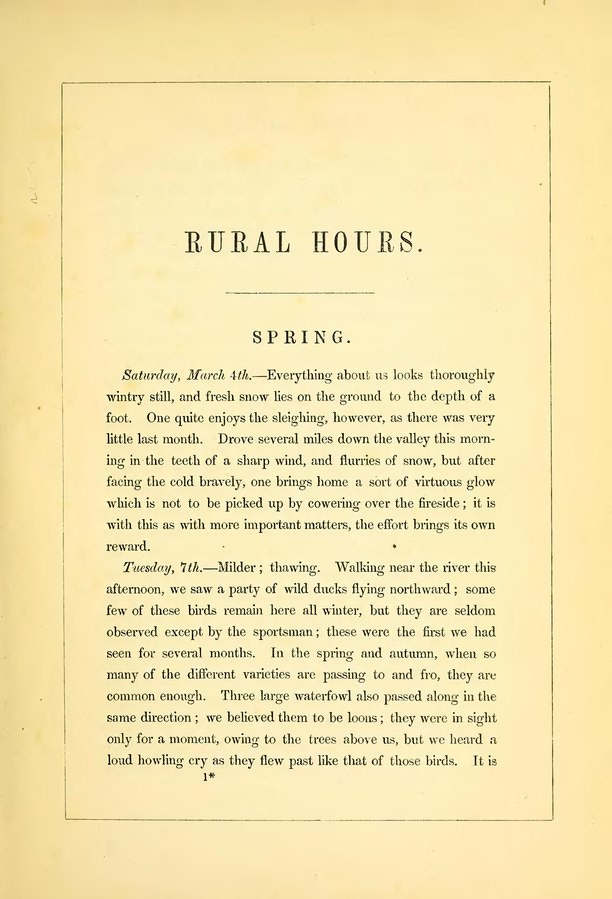Last week, the spring equinox arrived. I continue to value natural rhythms against the backdrop of the human-dominated calendar where 8 to 5 is a year-round rhythm for too many of us. Signs outside my window are good cues to nature’s beats, but I take prompting from books, too.
For The Library this week, I turned my attention to a book I have long wanted to read, Rural Hours (1850) by Susan Fenimore Cooper. Given time constraints, I focused just on the section devoted to spring, where I got a good taste of Cooper’s approach. Read on!
Book, Author, and Storied Family
I used to teach an excerpt of Rural Hours in my environmental history courses from an anthology I used. Cooper’s meditation on weeds and on private property in that selection interested me. I wanted to know more, so I bought Rural Hours year ago, and it has languished too long on my shelf.
I have considered cracking it open for Taking Bearings before, but every time I thought of it I worried I would not finish it in time. Since the author organized it by seasons, though, I think I might try to revisit it four times this year, starting now.
Many of you will find the author’s name familiar. Her father was James Fenimore Cooper, the famous author of the Leatherstocking Tales and other pieces of 19th-century American literature. His father was William Cooper, founder of Cooperstown, New York, who was the subject of the Pulitzer Prize-winning history, William Cooper’s Town.

All of which is to say that Susan Fenimore Cooper occupied a relatively privileged place in American life, although there were limits. The cover of Rural Hours identified the author simply as "A Lady," suggesting both her class and gender position.
Prose, Plan, and Place
The great final spring thaw going on. Our winter deluge of snow is sinking into the earth, softening her bosom for the labors of the husbandman, or running off into the swollen streams, toward the sea.
That passage encapsulates a big part of the season’s story in Rural Hours and a good sample of Cooper’s prose: naturally specific with artful glosses.
Cooper spent 1848 and 1849 observing the natural community around her. (So far, anyway, she spends little on her human neighbors.) She decided to transform her journal entries into a book, organizing it by season and beginning with spring. Her locale was her home in central New York around Otsego Lake.
Book of Changes
Cooper observes closely, and those observations reveal a world of change—both in the immediacy of the season and in the arc of history.
Much of the “Spring” section of Rural Hours chronicles the comings and goings of flora and fauna (mainly birds). Because of her careful attention, we can pinpoint when robins arrived, for instance, or when the apple trees blossomed:
The apple-trees are in blossom—they opened last night by moonlight; not one was in flower yesterday, now the whole orchard is in bloom.
But Cooper (like her father) paid attention to the changes brought by white settlement, finding more than a little mixed results.1
When this valley was first peopled by the whites, quails were also found here in abundance, among the common game-birds of the region, but thy have now abandoned us entirely; one never hears of them, and it is said that they soon disappeared after the country had been cleared.
Cooper’s attention to change, and causation, turns Rural Hours into an instructive account, not merely a descriptive one.
She reports wildflowers diminishing in numbers and birds being introduced and expanding their hold. Even climate had changed since colonization. Her writing makes clear that change over time in the natural world—and its possible causes and consequences—constituted a regular part of regional conversation, as common in the 1840s as it is in the 2020s.
Occasional Annoyances of Spring . . .
Spring is, I think sometimes, a frustrating season. It is slow to be steady, seemingly reversing itself often to winter before heading definitively toward summer.
At times, I think Cooper finds spring frustrating, too. With snow melting, “The whole country is brown again,” reported Cooper, adding, “Nothing can look more dismal than the lake just now.” I often find this transition similarly dreary.
But, Cooper detailed the “sudden outburst of spring in America” that eventually produced “the sudden gush of life and joyousness . . . [that is] almost magical in its beautiful effects.” The greening of the hillsides and fields brighten the mood, but reversals come, too.
In early May she complained that it was too wet to go walking, and “the fires are lighted again” to warm up the home. How often are we, especially in the Northwest, fooled in thinking that we turned the seasonal corner only to have to dig out that heavy winter rain gear one more time?
Throughout the book, Cooper walks, routinely and intentionally. “Walked in the woods looking for flowers,” Cooper said about April 15. (Rural Hours takes the form of a journal, though not every date is included.) This kind of walking was for pleasures and natural history. She was not checking fences or crops, yet another sign of her class. But this example of leisurely studying nature feels early and attentive. In this way, Cooper was a harbinger of other writers.
. . . and People
Occasionally, you can sense a tiredness about humans. Cooper took these walks with others—she frequently referred to “we”—but society may not always have been welcome.
[T]he ear, wearied with the din of folly and falsehood, will gladly open to sounds of gentle harmony from the gay birds, the patient cattle, the flowing waters, the rustling leaves.
Here, nature is a balm, a salve against humans who are loud and liars. At least, that is my interpretation. The larger context of this passage suggests Cooper is trying to turn her reader to the works of God, the source of the natural scene, in Cooper’s view.
Preliminary Report
Rural Hours, at least so far, is pleasant as reading. And I expect I’ll keep enjoying it. I would guess if I were a New Yorker, I’d find it even more relevant and insightful. I’d love to find a similar volume from this area!
The editors note that Cooper was the first American woman to publish a book of nature writing. That gives Rural Hours some importance just by its existence. Its form and content are worth studying as an exemplar and historical artifact. Yet I think modern readers might get even more out of it.
Someone could use this to track climate change. The dates when birds arrived and flowers bloomed; the name of species as common, diminishing, or increasing; the observations Cooper shares from her neighbors who experienced change over decades—all of these and more can help us today understand a moment of change in the early republic and how it compares to today.
It is that change—a momentous, busy time for the nation, as well as spring itself—that makes the opening of Rural Hours a transformative volume.
Closing Words
Relevant Reruns
A contemporary of Cooper’s was Henry David Thoreau, and you can read my newsletter devoted to him here.
Last week was the 10-year anniversary of the mudslide I described here. Because many retrospectives have appeared in local media, I’ve been thinking about this.
New Writing
A local sign maker has an exhibit in our county history museum. I interviewed him in advance of the opening reception. He and his story are delightful. You can read about it here.
As always, you can find my books, and books where some of my work is included, at my Bookshop affiliate page (where, if you order, I get a small benefit).
Taking Bearings Next Week
The Wild Card pops up next week, allowing me an opportunity to be creative. Stay tuned!
The one section where she writes of the indigenous population reveals that she adopted the “vanishing race” trope, as her father did.






